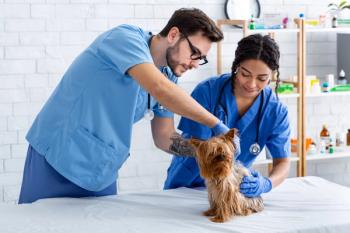
What to monitor and why! The essentials: Cardiovascular, respiratory, and temperature (Proceedings)
A good anesthetist must have an understanding of normal physiology - as this it is altered by general anesthesia.
Introduction
A good anesthetist MUST have an understanding of normal physiology- as this it is altered by general anesthesia. An understanding of pathophysiology (when a disease is present) is also essential is be able to monitor effectively. If a disease is life threatening, multiple monitoring tools are available to help aid the human senses. Without continuous monitoring complications are often not detected until much advanced and possibly irreversible. If a death does occur, it would be difficult to know what led to death, without the help of careful monitoring. Anesthetics are not safe; the anesthetist is what makes them safe. It is also pertinent to record everything you do. In order to monitor effectively, the veterinarian, technician, or other responsible person should check the patient's status at least every 5 minutes during anesthesia and recovery! Some common complications encountered in anesthesia are hypotension, hypoventilation, hypoxemia, hypothermia & pain.
Respiratory System Monitoring (Tools)
Respiratory rate (RR)
This will vary with species. Also chest excursions- indication of VT (tidal volume), Respirometry- VT and VE (minute ventilation), Capnography- end tidal CO2 (carbon dioxide), Pulse oximetry- SpO2 (saturated percent of oxygen) & Blood gas analysis.
Tidal Volume (VT)
The volume of gas entering and leaving the patient's respiratory system during the inspiratory and expiratory phase time (normally 10-20ml/kg) - it can be measured by respirometry. When choosing a breathing bag size, you should calculate >5 times tidal volume to decrease airway resistance.
Rate Monitors and Apnea Alarms
A thermistor is placed in patient airway (between ET tube and breathing system).This changes in resistance as warmed gases pass over thermistor; which get converted to electrical signal. Machine beeps with each expiration and can be set to alarm if no breath for pre-set period of time.
Respirometry
Measures tidal volume & minute ventilation. They are computerized or digital.
Respiratory Monitoring and Physiology
Respiratory Function- Maintenance of adequate respiratory function is a prime requirement for safe anesthesia. Excessive increases in PaCO2 (arterial carbon dioxide pressure) or moderate hypoxemia can contribute to poor organ function and can lead to anesthetic fatalities. Physiologically, cellular metabolism leads to constant production of carbon dioxide. CO2 is produced in the tissues and diffused into venous blood which then reaches the right side of the heart then lungs via pulmonary circulation. CO2 is eliminated mostly by the lungs and to a smaller degree, the kidneys. The respiratory centre in brain stem is sensitive to changes in CO2 in blood. Ventilation should increase in response to increases in CO2. If PaCO2 doubles, ventilation should double also (conscious patient). A normal PaCO2 is maintained between 35-45 mmHg (millimetres of mercury). A measurement of CO2 levels in arterial blood gives the most reliable indication of adequacy of ventilation. We must also ensure adequate oxygen concentration in the patient's arterial blood to avoid a hypoxemic episode. There are three common methods to measure oxygenation. A simple way is to observe of mucous membrane color, which is not a very sensitive method. A more accurate method is pulse oximetry (noninvasive estimation of hemoglobin saturation). The best is arterial blood gas analysis.
Capnography
Monitoring ETCO2 (end tidal carbon dioxide). This is a non-invasive continuous measurement of carbon dioxide from the patient. It provides an indication of adequacy of ventilation (hypoventilation (ETCO2 >45mmHg) or hyperventilation (ETCO2 <35mmHg). There are characteristic traces that are produced for specific situations. It's a useful monitor for assessing ventilator settings. Also, can determine accuracy of intubation (ETT obstruction) as well as circuit malfunction & disconnection. It can be used as a cardiovascular monitor as CO2 is produced when there is cardiac output. Another method of measuring CO2 is through capnometry. This method will provide you with an ETCO2 number, not a waveform.
Analyzing Capnograph Waveform
The waveform will rise and fall with detectable CO2. If no CO2 is detectable, check to see if your patient is alive or properly intubated. If CO2 is unloading into the lungs through pulmonary circulation, then if your patient has little or no cardiac output, CO2 would not be eliminated during expiration. This would make a capnograph useful in cardiopulmonary resuscitation The ET CO2 value (the number at the highest point to the right determines the height of the waveform)? If you look at the shape of the wave, it will indicate normal breathing or particular breathing patterns such as hypoventilation (ETCO2 >45mmHg) or hyperventilation (ETCO2 <35mmHg). Another common abnormal wave pattern is rebreathing of CO2. If your patient is rebreathing CO2, the soda lime may be exhausted, the unidirectional valves on the anesthesia machine may be malfunctioning, there may be excessive dead space, or in the case of a non-rebreathing system, the oxygen flow may be too low. Great capnograph web site:
Hypo- and hyperventilation
Pulse oximetry
This tool is a non-invasive continuous measurement of the percent of saturated hemoglobin bound with oxygen. A pulse oximeter recognizes pulses. This is how it differentiates venous blood from arterial blood. The monitor uses a light emitter with red and infrared LED's (light emitter diodes). They will transduce through an area of body with good blood flow such as the tongue, toe web, lip pinna, leg, vulva, rectum, fold of flank, tail. Opposite the emitter is a photodetector that receives the light that passes through the measuring site. There are two types of probes. With the transmission probe, the emitter & photodetector are opposite each other. A reflectance probe has the emitter and photodetector next to each other. Patient movement, ambient lighting, vasoconstriction, hypothermia, drugs, compression of tissue, low output states, pigment, & thickness can interfere with function of this tool.
Blood Gas Analysis
This test is the gold standard of respiratory monitoring. Advantages are: Accurate, larger picture of entire respiratory/acid-base system. PaO2 (arterial oxygen tension) PaCO2, pH; calculated bicarbonate, base deficit, SaO2 (saturated oxygen). Blood gas cartridges can also include electrolytes & lactate as well as many other biochemistry profiles. Disadvantages are: Invasive arterial stick, time-consuming, equipment cost and maintenance, single sample (sample is not a constant measurement), technically demanding.
Cardiovascular Monitoring & Physiology
In monitoring the cardiovascular system, one should be most concerned with delivery of adequate blood flow to the patient's tissues. Cardiac Output = SV x HR. MAP is product of CO & SVR
SV- Stroke volume
HR- Heart rate
MAP- Mean arterial blood pressure
SVR- Systemic vascular resistance
Monitoring CV- Tools.
Heart rate (HR)
Stethoscope (esophageal), Palpation of a peripheral pulse (PP), MM color and CRT, Arterial blood pressure (ABP); both Indirect non-invasive & Direct invasive &Electrocardiography (ECG)
The HR & stethoscope will provide some information on cardiac output and rhythm.
Pulse palpation (PP)
The reflection of SV. It is the difference between systolic and diastolic pressure. The pulse is usually not palpable if MAP <40 mmHg. One should ascultate the heart rate while synchronysly palpating the pulse.
Pulse Locations on the dog and cat:
DOG → femoral, tibial, dorso-pedal, palmar digital, lingual, caudal arteries
CAT → femoral, tibial ± dorso-pedal ± caudal
Pulse Pressure
SAP – DAP The difference between systolic and diastolic (strong pulse = large PP, weak pulse = small PP) A pulse may feel similar even though the mean arterial blood pressure is different.
EXAMPLES:
SAP = 120, DAP = 90, MAP = 100, PP = 30
SAP = 90, DAP = 60, MAP = 70, PP = 30
Mucous Membrane Color and Capillary Refill time
Sign of oxygenation & peripheral perfusion
- MM pink: CRT<2s
-Pale MM: hypotension, hypothermia, hypoxemia, vasoconstriction, or low PCV
-Red brick MM & CRT >2s: venodilation, blood sludging, hypercarbia, endotoxemia
Arterial Blood Pressure (mmHg)
A sensitive method of measuring tissue perfusion.
Non-invasive
Doppler or Oscillometry or Invasive- arterial catheterization. With non-Invasive ABP: Doppler- The Cuff Size important. It should be 30-40% limb circumference. If the cuff is too small, you may see falsely high readings. If it's too large, you may read falsely low readings. Hypotension is a SAP < 90 mmHg. The sound will disappear w/ SAP < 40 mmHg. Always check patient 1st, if monitoring tools fail.
Direct BP Measurement-
Invasive arterial catheterization. This is the gold standard of blood pressure measurement and is the most sensitive method for measuring blood pressure in the clinical setting. Complications associated with IBP- Hematoma, intra-arterial injection, infection, hemorrhage, or tissue necrosis. It is important to label the catheter, to avoid confusing the arterial catheter with the venous.
Electrocardiography (ECG)
Should not be relied upon as the sole monitor of cardiovascular function. Gives electrical function of the heart, not blood flow. Gives no information on cardiac output. After death...still may see Pulseless Electrical Activity = EMD. HR derived from R-R intervals, possible beat to beat variations. The decision to treat an arrhythmia is based upon assessment of impact on hemodynamic function. If there is an arrhythmia present measure blood pressure, palpate pulse and observe MM colour and CRT. Be familiar with a normal ECG and be able to interpret abnormal. Common abnormalities that will alter a normal electrocardiogram under general anesthesia are catecholamine release, hypoxemia, hypercapnia, electrolyte imbalances, certain anesthetic drugs, myocardial ischemia, trauma, GDV (gastric dilatation volvulus) An ECG is a must for performing CPCR (cardiopulmonary cerebral resuscitation).
Thermoregulation
Thermoregulation is governed by hypothalamus. A response to a temperature change is based on your patient's mean body temp. A patient responds to cold via one of the following methods: vasoconstriction, non shivering thermogenesis, shivering, piloerection, puffing of feathers, or lowering of body temp. A patient responds to warmth by sweating, vasodilation, panting or salivation. Anesthesia inhibits vasoconstriction & alters thermoregulation mechanisms. Hypothermia will result if heat production is less than heat loss. Hypothermia slows metabolism, shivering will increase oxygen consumption (recovery). Perioperative hypothermia is a common, treatable complication of general anesthesia. Monitor accordingly and continuously. Treat accordingly. There are many ways to measure and to support. A patient should be monitored until normothermic. A rectal thermometer or esophageal probes are ideal as they reach core body temperature. Nasal or buccal temperatures are lower than core by several degrees. We identify hypothermia as <35°C or <96°F.
Temperature Support Tools
Forced air warming devices (most efficient), circulating warm water blankets, warm IV fluids as well as isotonic lavage fluids, wrap extremities with insulation (socks, bubble wrap), heat lamps (make sure far enough distance so patient does not develop burns) as well as any other warmed device (ALWAYS check temperature to avoid thermal burns).
References
Greene, Stephen A: Veterinary Anesthesia and Pain Management Secrets, Philadelphia, Hanley & Belfus, Inc., 2002
McKelvey D, Hollingshead KW: Veterinary Anesthesia and Analgesia, 3rd ed. St. Louis, Mosby, 2003
Meyer & Harvey: Veterinary Laboratory Medicine Interpretation & Diagnosis, 2nd ed. Philadelphia, W.B. Saunders,1998
Muir W, Hubbell J, Bednarski R: Handbook of Veterinary Anesthesia, 4th ed. St. louis, Mosby, 2007
Paddleford: Manual of Small Animal Anesthesia, 2nd ed. Philadelphia, W.B Saunders, 1999
Seymour C, Gleed R: Manual of Small Animal Anaesthesia and Analgesia, Shurdington, UK, BSAVA, 1999
Thurmon J, Tranquilli W, Benson G: Essentials of Small Animal Anesthesia & Analgesia, Philadelphia, Lippincott Williams & Wilkins, 1999
Newsletter
From exam room tips to practice management insights, get trusted veterinary news delivered straight to your inbox—subscribe to dvm360.




